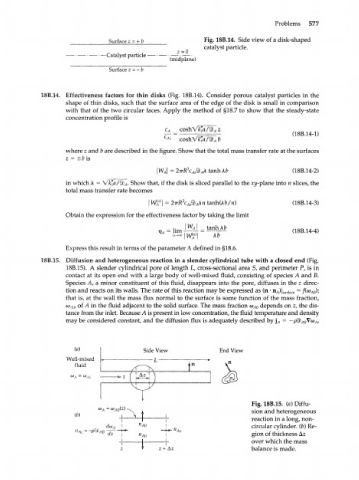Page 597 - Bird R.B. Transport phenomena
P. 597
Problems 577
Surface z = + b Fig. 18B.14. Side view of a disk-shaped
catalyst particle.
Catalyst particle
(midplane)
Surface z = - b
18B.14. Effectiveness factors for thin disks (Fig. 18B.14). Consider porous catalyst particles in the
shape of thin disks, such that the surface area of the edge of the disk is small in comparison
with that of the two circular faces. Apply the method of §18.7 to show that the steady-state
concentration profile is
(18B.14-1)
where z and b are described in the figure. Show that the total mass transfer rate at the surfaces
z = ±bis
№ (18ВЛ4-2)
in which A = \/k"a/%b . Show that, if the disk is sliced parallel to the xy-plane into n slices, the
A
total mass transfer rate becomes
| W A n) (18B.14-3)
Obtain the expression for the effectiveness factor by taking the limit
tanhAfr
(18B.14-4)
Express this result in terms of the parameter Л defined in §18.6.
18B.15. Diffusion and heterogeneous reaction in a slender cylindrical tube with a closed end (Fig.
18B.15). A slender cylindrical pore of length L, cross-sectional area S, and perimeter P, is in
contact at its open end with a large body of well-mixed fluid, consisting of species A and B.
Species A, a minor constituent of this fluid, disappears into the pore, diffuses in the z direc-
tion and reacts on its walls. The rate of this reaction may be expressed as (n • п )| 5игГасе = f(<o );
л
A0
that is, at the wall the mass flux normal to the surface is some function of the mass fraction,
(х) , of A in the fluid adjacent to the solid surface. The mass fraction со depends on z, the dis-
А0
ло
tance from the inlet. Because A is present in low concentration, the fluid temperature and density
may be considered constant, and the diffusion flux is adequately described by ) A = -p4b ^a) ,
A
A
(a)
Well-mixed
fluid
Fig. 18B.15. (a) Diffu-
sion and heterogeneous
ib)
reaction in a long, non-
circular cylinder, (b) Re-
gion of thickness Az
over which the mass
z + Az balance is made.

